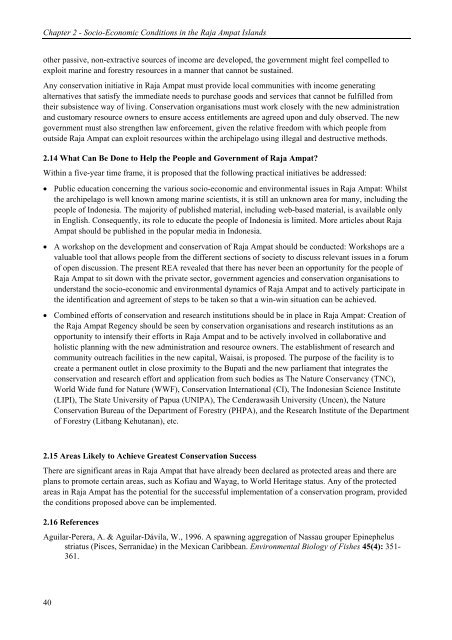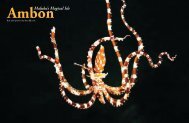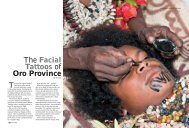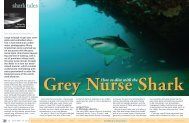Rapid Ecological Assessment - Indo-Pacific Images
Rapid Ecological Assessment - Indo-Pacific Images
Rapid Ecological Assessment - Indo-Pacific Images
- No tags were found...
Create successful ePaper yourself
Turn your PDF publications into a flip-book with our unique Google optimized e-Paper software.
Chapter 2 - Socio-Economic Conditions in the Raja Ampat Islands<br />
other passive, non-extractive sources of income are developed, the government might feel compelled to<br />
exploit marine and forestry resources in a manner that cannot be sustained.<br />
Any conservation initiative in Raja Ampat must provide local communities with income generating<br />
alternatives that satisfy the immediate needs to purchase goods and services that cannot be fulfilled from<br />
their subsistence way of living. Conservation organisations must work closely with the new administration<br />
and customary resource owners to ensure access entitlements are agreed upon and duly observed. The new<br />
government must also strengthen law enforcement, given the relative freedom with which people from<br />
outside Raja Ampat can exploit resources within the archipelago using illegal and destructive methods.<br />
2.14 What Can Be Done to Help the People and Government of Raja Ampat?<br />
Within a five-year time frame, it is proposed that the following practical initiatives be addressed:<br />
• Public education concerning the various socio-economic and environmental issues in Raja Ampat: Whilst<br />
the archipelago is well known among marine scientists, it is still an unknown area for many, including the<br />
people of <strong>Indo</strong>nesia. The majority of published material, including web-based material, is available only<br />
in English. Consequently, its role to educate the people of <strong>Indo</strong>nesia is limited. More articles about Raja<br />
Ampat should be published in the popular media in <strong>Indo</strong>nesia.<br />
• A workshop on the development and conservation of Raja Ampat should be conducted: Workshops are a<br />
valuable tool that allows people from the different sections of society to discuss relevant issues in a forum<br />
of open discussion. The present REA revealed that there has never been an opportunity for the people of<br />
Raja Ampat to sit down with the private sector, government agencies and conservation organisations to<br />
understand the socio-economic and environmental dynamics of Raja Ampat and to actively participate in<br />
the identification and agreement of steps to be taken so that a win-win situation can be achieved.<br />
• Combined efforts of conservation and research institutions should be in place in Raja Ampat: Creation of<br />
the Raja Ampat Regency should be seen by conservation organisations and research institutions as an<br />
opportunity to intensify their efforts in Raja Ampat and to be actively involved in collaborative and<br />
holistic planning with the new administration and resource owners. The establishment of research and<br />
community outreach facilities in the new capital, Waisai, is proposed. The purpose of the facility is to<br />
create a permanent outlet in close proximity to the Bupati and the new parliament that integrates the<br />
conservation and research effort and application from such bodies as The Nature Conservancy (TNC),<br />
World Wide fund for Nature (WWF), Conservation International (CI), The <strong>Indo</strong>nesian Science Institute<br />
(LIPI), The State University of Papua (UNIPA), The Cenderawasih University (Uncen), the Nature<br />
Conservation Bureau of the Department of Forestry (PHPA), and the Research Institute of the Department<br />
of Forestry (Litbang Kehutanan), etc.<br />
2.15 Areas Likely to Achieve Greatest Conservation Success<br />
There are significant areas in Raja Ampat that have already been declared as protected areas and there are<br />
plans to promote certain areas, such as Kofiau and Wayag, to World Heritage status. Any of the protected<br />
areas in Raja Ampat has the potential for the successful implementation of a conservation program, provided<br />
the conditions proposed above can be implemented.<br />
2.16 References<br />
Aguilar-Perera, A. & Aguilar-Dávila, W., 1996. A spawning aggregation of Nassau grouper Epinephelus<br />
striatus (Pisces, Serranidae) in the Mexican Caribbean. Environmental Biology of Fishes 45(4): 351-<br />
361.<br />
40





